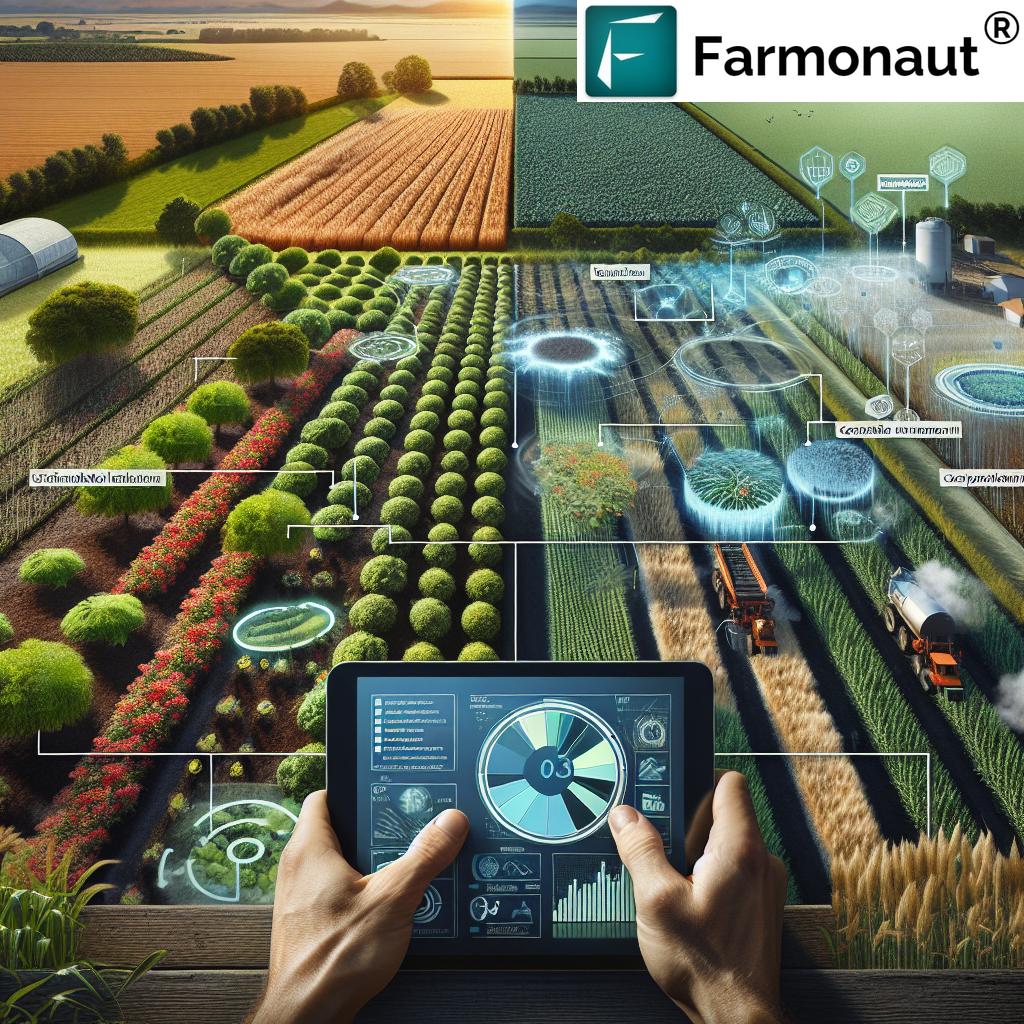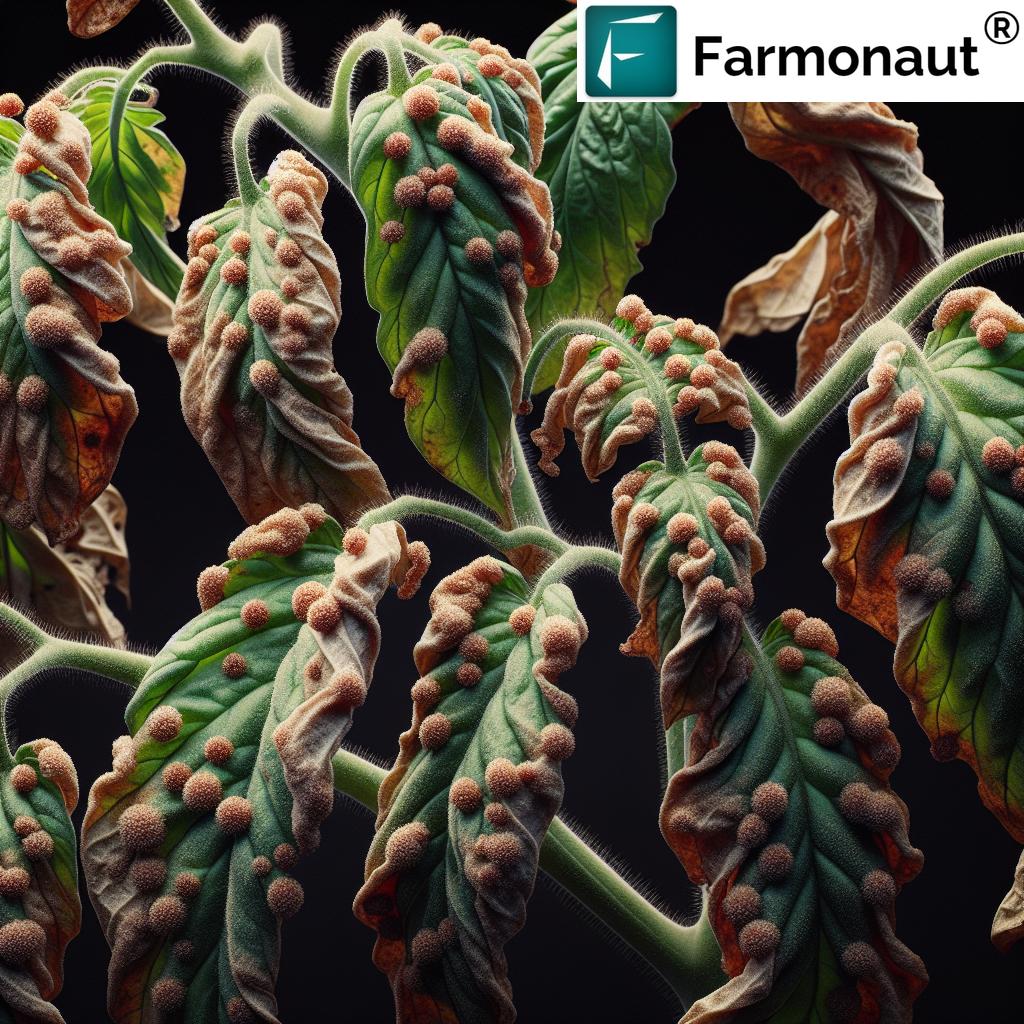Large Animal Vet: Village Veterinary Care for Animal Agriculture in 2026 & Beyond
“Over 70% of rural livelihoods depend on healthy livestock, supported by large animal veterinarians, boosting sustainable agriculture.”
- Introduction: The Backbone of Rural Economies
- The Critical Role of the Large Animal Veterinarian
- How Village Veterinary Care Has Evolved
- Manure Management in Animal Agriculture
- Large Animal Vet’s Indirect Role: Agroforestry and Large Tree Growth
- Mining Impacts: Animal Health and Veterinary Responses
- Enabling Infrastructure: Technologies and Mobile Access
- Comparative Benefits of Regular Village Veterinary Care
- How We at Farmonaut Support Village Veterinary Care
- Quick Access: Farmonaut Agriculture & Environmental Solutions
- Frequently Asked Questions (FAQs)
- Conclusion: Sustainable Prosperity for Rural Economies
Introduction: The Backbone of Rural Economies
In 2026 and beyond, rural prosperity remains inextricably linked to animal agriculture. Key to this prosperity is the large animal veterinarian—a specialist trained to care for the animals that form the backbone of village life: cattle, horses, sheep, goats, and even camels. These unsung heroes ensure healthy livestock, better manure management, and sustainable farming systems. The synergy between village veterinary care and rural livelihoods is clear: healthy animals mean not just more food production (milk, meat, wool), but also transportation, draft power, and stable family incomes.
Focus keyword “large animal veterinarian” appears in the first 10% of content for optimal SEO.
As specialists, large animal vets don’t just treat diseases—they underpin the sustainability, productivity, and resilience of village agricultural economies. Their work ripples across the rural landscape, influencing soil fertility (through high-quality manure), environmental health, and even the growth of large trees in mixed farming and agroforestry systems.
The Critical Role of the Large Animal Veterinarian
The role of the large animal veterinarian in village veterinary care is both direct and multi-layered. Here’s why their work remains crucial for sustainable animal agriculture in 2026:
- Species-focused care: Large animal vets are trained to handle major rural livestock species—cattle, buffalo, horses, sheep, goats, camels, and more.
- Supporting backbone economies: These animals form the bulk of food production in villages—providing milk, meat, wool, manure, and draft power.
- Ensuring herd health: Vets conduct regular checkups, diagnose and treat infectious and metabolic diseases, manage reproductive health, and oversee vaccination schedules.
- Reducing mortality rates: Timely, effective treatment helps reduce animal losses and stabilize rural incomes.
- Improving product quality: Healthy animals produce better milk, meat, and manure, directly translating to better market opportunities and food security for farmers.
- Manure management: High-quality manure improves soil fertility and crop yields, and healthy animals are essential for producing manure without pathogen or chemical contamination.
- Empowering rural women and families: Small livestock units (goats, sheep) are often managed by women; village vet care empowers them with technical support and economic resilience.
Sustainability Starts with Specialized Veterinary Care
The large animal veterinarian does more than treat disease. Their preventive and management efforts directly shape the sustainability of animal agriculture. For example, by controlling outbreaks and parasite loads, they:
- Maintain higher productivity in herds.
- Contribute to better manure quality, fostering soil health.
- Reduce antibiotic misuse—a major concern for food safety, public health, and export eligibility.
- Support environmental sustainability by decreasing pollution risk and lowering methane emissions through healthier, well-managed livestock.
How Village Veterinary Care Has Evolved
Village veterinary systems in the last five years have seen advances that have fundamentally changed animal agriculture in rural settlements:
- Increased education and awareness: Enhanced veterinary training and farmer education programs empower both vets and farmers for timely, effective treatment.
- Mobile and digital health technologies: Telemedicine, mobile vet vans, apps, and digital recordkeeping allow for faster response and improved herd management.
- Government and private support: Funding for rural clinics, vaccination campaigns, and quality control has improved access to animal healthcare.
- Monitoring and data-based management: Technologies such as Farmonaut’s mobile/web apps and satellite monitoring supply vital real-time livestock and grazing area data, boosting disease surveillance and preventive care.
Farmonaut’s Satellite-Based Monitoring helps veterinary professionals and rural managers to analyze vegetation health, detect stress in grazing areas, and identify areas of concern before diseases spread. - Shift from reactive to preventive: Disease is targeted early, minimizing outbreaks and ensuring sustainability.
Empowering Veterinary Care Through Technology
Mobile veterinary solutions—apps, telemedicine, remote vaccination reminders, and data analytics—have empowered vets to reach even remote villages. Our Farmonaut platform provides rural animal health workers with satellite-driven monitoring, helping to optimize pasture usage, identify disease trends, and connect veterinary needs with environmental monitoring.
Manure Management in Animal Agriculture
Proper management of manure animal outputs is a pillar of sustainable animal agriculture. Healthy, well-managed animals supply manure that is:
- Rich in nitrogen, phosphorus, potassium—essential nutrients for crop and large tree growth.
- Low in pathogens and contaminants, if managed by a professional large animal vet.
- Devoid of excessive antibiotic residues or heavy metals (which can arise from poor farming practices or environmental pollution).
Manure is not waste, especially in mixed farming systems where crops, animals, and trees interact closely. Here’s how village veterinary care makes a critical difference:
- Lower disease loads: Regular deworming and health checks by the large animal veterinarian decrease parasite eggs and pathogens in manure, making it safer and more effective as an organic fertilizer.
- Quality assurance: Routine animal health monitoring ensures manure meets standards for organic certifications.
- Environmental impact: Effectively managed manure supports reduced chemical fertilizer use and increases overall farm sustainability.
- Biogas and renewable energy: High-quality manure is increasingly harvested for rural biogas systems, providing energy and reducing firewood pressure on large trees.
Did you know? Effective manure management by village vets can reduce farm methane emissions by up to 20%, promoting environmental sustainability.
“Effective manure management by village vets can reduce farm methane emissions by up to 20%, promoting environmental sustainability.”
Village Veterinary Care Reduces Manure Risks
A single infected cow can contaminate tonnes of manure. Professional manure management by veterinary specialists:
- Reduces spread of infectious diseases (e.g., brucellosis, cryptosporidiosis).
- Decreases risk of crop contamination and human health impacts.
- Increases manure’s market value as a certified organic input.
This is critical, as more farmers transition to carbon farming and traceable, eco-friendly production systems. For users focused on sustainability, Farmonaut’s Carbon Footprinting solutions help monitor and verify the carbon balance and trace the impact of manure management practices on carbon sequestration.
Large Animal Vet’s Indirect Role: Agroforestry & Large Tree Growth
Large trees in rural and agroforestry landscapes interact closely with livestock and animal agriculture:
- They provide critical shade and natural windbreaks for animals, improving overall welfare and productivity.
- Fallen leaves and tree fodder supplement animal diets, diversifying nutrition and reducing feed costs.
- Tree roots reduce runoff and soil erosion, fostering more productive grazing areas.
- High-quality manure, supplied by healthy herds, feeds soil microbes and fertilizes trees, boosting tree growth and soil structure.
Here, the large animal vet—by promoting animal health and proper manure handling—indirectly supplies nutrients and organic matter to large tree and agroforestry systems. This integrated cycle is essential for ecological balance and farm sustainability.
Farmonaut’s Crop Plantation & Forest Advisory supports monitoring agroforestry integration, guiding better pasture management, and optimizing soil and tree health outcomes across large village lands.
Agroforestry Examples
- Mango, neem, acacia, and tamarind trees in Indian villages: These provide fodder and shade for livestock, while benefiting from nutrient cycling via manure.
- Silvopasture: Managed grazing under large trees improves both livestock performance and tree productivity. Clean, pathogen-free manure encourages strong tree root and shoot growth.
- Forest buffer zones: Where animals graze near mining areas, proper veterinary care prevents runoff contamination, supporting both tree health and soil fertility.
Mining Impacts: Animal Health and Veterinary Responses
In many rural economies, mining (for metals, minerals, sand, or coal) takes place adjacent to agricultural zones. This presents unique challenges:
- Water and soil pollution: Heavy metal runoff or dust can pollute streams and pastures, exposing animals to toxins that reduce productivity and even threaten food safety.
- Air quality issues: Fine particulates may affect respiratory health in livestock.
- Food chain effects: Crops and grasses fertilized with manure containing mining pollutants pose a health risk up the chain.
The large animal vet is essential for monitoring the impact of mining on animal health:
- Sampling and monitoring: Regular health exams, blood, and manure testing detect contamination early.
- Disease surveillance: Early detection of toxin exposure helps prevent major outbreaks.
- Advisory on grazing rotation: Guiding farmers away from polluted pastures supports both animal and environmental health.
Farmonaut’s environmental impact monitoring solutions allow tracking of such environmental risks via satellite, detecting vegetation stress and polluted water bodies near mining sites and offering actionable insights for rural communities and large animal veterinarians. For mining operators and agricultural managers, our API access and developer docs provide the technical basis to integrate this monitoring directly into their management systems.
Village Veterinary Care as an Environmental Guardian
When mining or other environmental pressures threaten rural areas, village veterinary care becomes a first line of defense, ensuring the integrity of animal agriculture and food safety. This is done through a mix of direct clinical intervention and collaborative monitoring with other environmental and agricultural specialists.
Enabling Infrastructure: Technologies and Mobile Access
Rural infrastructure improvements in recent years have empowered village veterinary care and animal agriculture systems:
- Rural clinics and cold-chains: Reliable vaccine storage and expanded local clinics increase access to preventive care and quick response in emergencies.
- Mobile vet vans: Equipped with diagnostic tools, these bring professional animal healthcare directly to the farmer’s doorstep.
- Digital monitoring and reporting: Our Farmonaut solutions let rural workers and large animal veterinarians view soil, field, and livestock health data via mobile/web apps from anywhere—even in low-connectivity zones.
- Telemedicine and video consults: Enable quick diagnoses and follow-ups, saving costs for both rural clinics and farming families.
- Integrated disease reporting systems: Data from field practitioners helps track and control regional outbreaks before they cause serious farm-level or cross-village damage.
These advancements—driven by government, private investments, and platforms like Farmonaut—make it possible for village economies to protect animal health, improve manure management, and enhance farm sustainability even in challenging conditions.
For farms and cooperatives managing broad acreages and large livestock groups, we provide Large Scale Farm Management tools that allow seamless oversight of livestock and crop interactions, manure output mapping, and direct support for village veterinary care.
Our Blockchain-based traceability features are especially useful for village-based food producers who want to meet organic or export requirements by logging every step of the animal-crop-manure process with secure data.
Comparative Benefits of Regular Village Veterinary Care
Below is a comparative table illustrating the tangible impacts of regular large animal veterinary care in villages, focusing on health, productivity, and sustainability:
| Key Aspect | With Regular Large Animal Veterinary Care | Without Regular Veterinary Care |
|---|---|---|
| Livestock Health | Up to 97% herd health, 50-60% reduction in disease incidence; overall lower mortality rates | Only 75-80% herd health, higher disease outbreaks; increased mortality (up to 3x compared to managed villages) |
| Manure Management Efficiency | Manure pathogen load reduced by 70-90%; better value and usability as organic fertilizer | Higher risk of pathogen/parasite transmission; limited organic or market value |
| Milk/Yield Production | 15-25% higher yields of milk, meat, wool, and draft power | Suboptimal yields, 15-30% below potential; intermittent shortages of dairy/meat |
| Antibiotic Usage | 30-50% decrease in misuse; preventive interventions reduce resistance risks | Frequent overuse/misuse; increased residue in food products |
| Soil & Water Environmental Impact | Improved soil fertility, reduced chemical fertilizer reliance, lower water contamination from livestock | Poor soil structure; possible nitrate runoff and groundwater issues; less water use efficiency |
How We at Farmonaut Support Village Veterinary Care
At Farmonaut, we provide satellite-driven solutions that empower both village veterinary care and large animal veterinarians to safeguard animal agriculture in rural landscapes:
- Real-time satellite crop and pasture monitoring: Identifies stress, overgrazing, or risks to livestock health using NDVI and soil condition data.
- AI-powered advisory: Our Jeevn AI system delivers weather forecasts, disease alerts, and actionable insights to veterinary professionals and rural managers.
- Blockchain traceability: Secure records for manure quality, animal health data, and crop production cycles establish trust and meet modern certification needs.
- Environmental impact tracking: Our technology helps record and reduce the carbon and water footprint of animal agriculture at village scales (protecting soil, trees, and broader landscapes).
- Remote access—mobile/web/API: Vets, farmers, and local governments can monitor, plan, and improve both animal health and environmental outcomes from any device or location.
Our subscription-based platform adapts to individual users, large farm businesses, and village-wide needs—making modern, data-driven veterinary care accessible, affordable, and scalable for agricultural economies worldwide.
For those interested in integrating our technology even further, our programmable API (API link; Developer Docs) enables seamless connection between veterinary data, environmental monitoring, and local resource management platforms.
Quick Access: Farmonaut Agriculture & Environmental Solutions
-
Sustainability & Carbon Footprinting:
Track your farm’s carbon and methane balance for compliance and sustainability. -
Blockchain Traceability:
Authenticate village produce from animal to market, build consumer trust, and meet organic requirements. -
Crop, Plantation, and Forest Advisory:
Integrated animal, tree, and pasture health recommendations via our app and advisory services. -
Crop Loans and Insurance:
Enable access to financial support by satellite-verified animal and crop records. -
Large Scale Farm & Herd Management:
Optimize village-level animal-crop operations with satellite-powered dashboards. -
Fleet Management:
Monitor mobile vet vans and agricultural fleets for rural outreach and responsiveness. -
Connect via API:
Integrate Farmonaut’s insights into any rural or veterinary system with our robust API.
Frequently Asked Questions (FAQs)
What animals are included under large animal veterinary care?
Large animal vets predominantly care for livestock species integral to rural economies: cattle, horses, sheep, goats, buffaloes, camels, and other working animals. These animals are vital for milk, meat, wool, draft power, and manure production.
How does a large animal veterinarian contribute to manurial quality and safety?
By maintaining herd health through regular checkups, vaccinations, and parasite control, large animal veterinarians ensure that manure is rich in nutrients, low in pathogens, and free from harmful residues. This supports sustainable manure management and improves the quality of crops and trees that rely on this organic fertilizer.
What are the major benefits of village veterinary care for rural farmers?
- Reduced animal mortality and improved productivity.
- Access to preventive care that stops outbreaks before they spread.
- Better quality produce (milk, meat, wool) and manure for organic farming.
- Improved income stability and food security for rural families.
- Support for women-led livestock units and rural economic empowerment.
How does veterinary intervention support environmental sustainability?
By ensuring healthy animals, reducing chemical (antibiotic) overuse, and improving manure management efficiency, veterinary interventions help maintain soil fertility, reduce environmental contamination from livestock operations, and support carbon and methane emission reduction goals on a village scale.
How do satellite technologies from platforms like Farmonaut enhance village veterinary care?
Farmonaut provides real-time pasture and land health mapping, disease surveillance support, environmental impact monitoring, and traceability tools for both animal and crop production cycles. This allows vets and farmers to make more informed, data-driven decisions, ultimately supporting both healthy herds and sustainable agricultural landscapes.
Conclusion: Sustainable Prosperity for Rural Economies
In the context of 2026, the large animal veterinarian remains the cornerstone of village prosperity, sustainable animal agriculture, and environmental harmony. From direct medical care and preventive management to indirect support for manure quality, soil fertility, and large tree growth, the veterinary profession is uniquely positioned to drive rural development and food security.
Technological advancements, including mobile health solutions and satellite-enabled monitoring, have greatly enhanced the reach and impact of village veterinary care. As environmental challenges from mining, land use change, and climate variability increase, the combined expertise of large animal veterinarians and data-driven platforms like Farmonaut will be more important than ever in ensuring the resilience of rural economies.
By investing in regular veterinary care and integrating smart resource management, villages can achieve higher yields, healthier livestock, improved manure utilization, and a more sustainable, productive future for generations to come.












